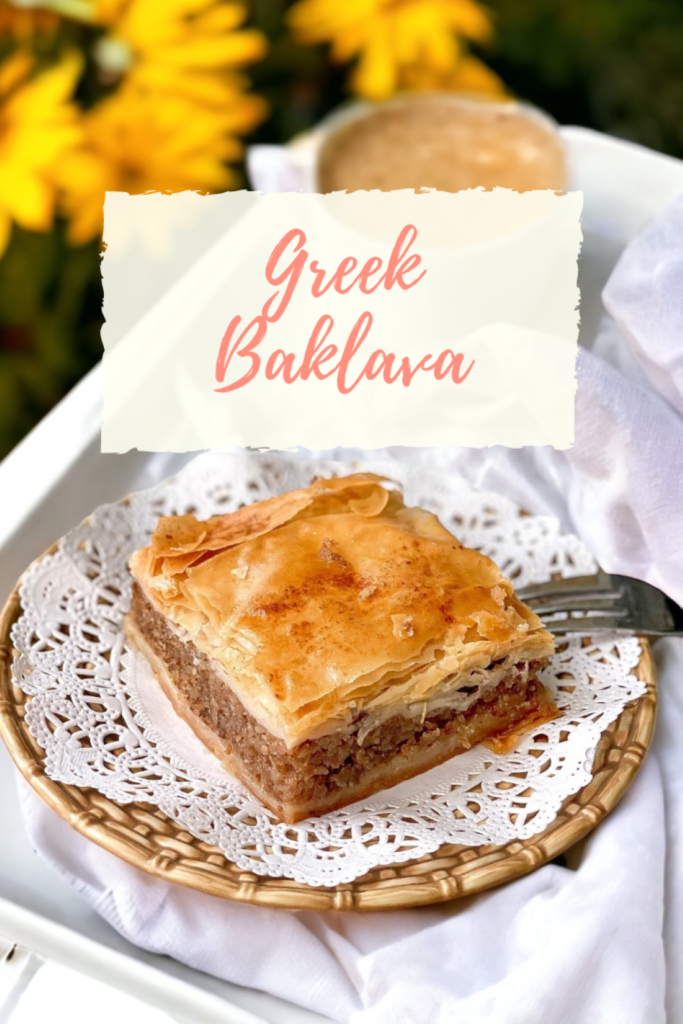You should not be surprised when you hear my Greek Baklava recipe is going to start with a bit of history. Before diving in, and if you are just looking to get to the baking, know that this baklava is different than the classic style baklava but it is easier to make and equally delicious! Can’t beat that.
The history
The first baklava is accepted as dating back all the way to 800 B.C. You read that right. In the Assyrian Empire, layers of bread dough were stretched thin, resembling phyllo, and baked with chopped nuts and honey. Sound familiar?
Fast forward today and we have 2 great countries fighting for the version to be known as the best- the Turkish version vs. the Greek version. The difference? It comes down to the nuts used and the spices within the syrup. There’s a lot of history between these 2 countries so for the sake of keeping things sweet, we’ll leave that out. Do know there are some generalizations here when distinguishing because recording history isn’t always perfect either!
My baklava is cut into 12 big squares and each can be later cut into 4 small squares or two triangles. I do this once baklava is completely cold.

Turkish baklava is known as pistachio baklava. This is the commonly accepted nut although there certainly are variations! The taste can even come down to where your pistachio nut is from, with some regions of Turkey known for their delicious pistachios and therefore, their superior baklavas. A simple syrup made from sugar, water, and lemon juice is poured on top. You’ll note, we’re going with this sweetener rather than honey.
The Greek version, on the other hand, uses honey generously to sweeten and soften its flaky bake. While we aren’t looking to the Greeks for this, the idea of using walnuts is credited to the traditional Greek version. And we will be using a whole pound of them! A final difference worth mentioning for this recipe is how we cut the baklava. We assemble the sheets and cut them into squares, whereas the Turkish version has a signature cigar role.
Whichever adaptation you go with, or if you find a combination of tradition creates your perfect baklava, don’t be intimidated! As complex and robust as baklava is, this recipe could not be simpler, nor more delicious! 😉
PrintGreek Baklava
Ingredients
- One pack of phyllo dough (1lb)
- 2 1/2 stick butter (1-1/4cup), melted
- Filling:
- 4 eggs
- 1/2 cup sugar
- 1/2 cup oil
- 1/2 cup all-purpose flour
- 1 tsp baking powder
- 1 lb. walnuts (chopped)
- Syrup:
- 3.5 cups sugar
- 3.5 cups water
- 2 tbsp fresh lemon juice
Instructions
Make the syrup first. It needs to cool before you pour it over your baklava. It can be prepared a day ahead and kept in the refrigerator.
- In a medium saucepan combine sugar, water and lemon juice.
- Bring to a boil, then reduce the heat to medium, and simmer for 10 minutes. Let cool.
- Preheat the oven to 360F.
- With a wire whisk, mix the eggs and sugar.
- Mix in oil, flour and baking powder.
- Add chopped walnuts and mix until all is blended.
- Split the phyllo in two. Start placing the first half of the phyllo sheets into a 13×9 baking pan one at a time. Brush each with melted butter as you place them into the baking pan.
- Pour the filling over layered sheets, and then repeat with the other half of the phyllo dough sheets.
- Brush the very top with butter, then mark the squares. Do not cut over corners as this will help the top layer to stay intact.
- Bake for 30-40 minutes, depending on your oven. It is ready once the top layer is golden brown.
- Now you can cut through the corners of marked squares.
- Spoon the cold syrup evenly over the warm baklava. Leave uncovered at room temperature until completely cooled and then store in the refrigerator.
- Once baklava is completely cooled you can cut it into triangles or smaller squares.
I also have an Apple Baklava you’re going to love.


